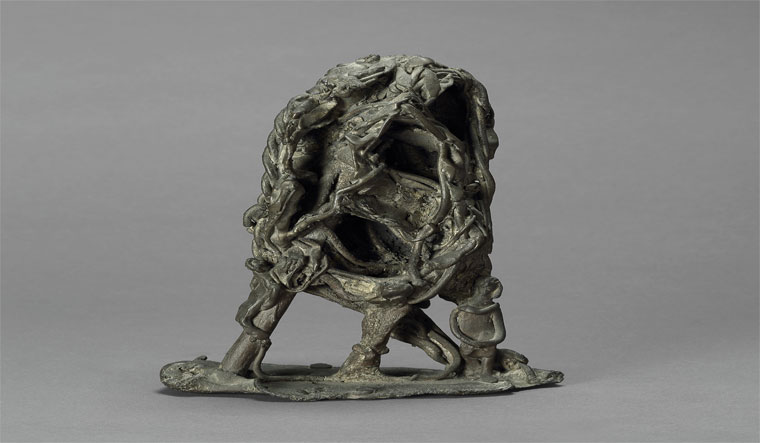Saffronart, the online auction house offering the most exhaustive range of modern and contemporary Indian art, turns 18 this year. To mark its entry into bona fide adulthood, Saffronart will host its 200th auction on Wednesday and Thursday. The Summer Online Auction features 150 modern and contemporary artworks, with Tyeb Mehta’s iconic Kali III (1989) as the definitive showstopper. There is also a 1965 Untitled canvas by V.S. Gaitonde, estimated at Rs 5.2-7.8 crore, among the top lots, not to mention Raja Ravi Varma’s Untitled (Shiva) and S.H. Raza’s Paysage Provencal-I (Cagnes). But going beyond the big-hitting painters, there are sculptors who are waiting to take off. In this important auction, going under the hammer will be key sculptures by artists like Himmat Shah, Prodosh Dasgupta, Sankho Chaudhuri and Meera Mukherjee. Dinesh Vazirani, CEO and co-founder of Saffronart, tells THE WEEK why the carved figures matter.
An untitled bronze work by Himmat Shah was sold for Rs 45.60 lakh at Saffronart last September. This was the fourth most expensive sculpture sold by an Indian artist that year. Is Himmat Shah the highest selling sculptor at Saffronart? What explains his popularity?
Saffronart’s most expensive sculpture in the modern section is a bronze sculpture by Meera Mukherjee, auctioned for Rs 50 lakh in February 2017. Both Mukherjee and Shah are highly sought-after modernists. Himmat Shah is among a generation of sculptors who were unafraid to experiment with form and subject matter. Shah incorporates diverse influences in his work, drawing upon personal history, as well as the collective narrative of civilisation. The fragility of human existence, which lies at the core of his work, resonates with art collectors around the world.
Can you tell us about some of the marquee sculptures up for auction in this special edition? Which ones do you expect to generate the most interest?
The sculptors represented in this collection are known for their bold experimentation and sensitive approach to the process of creating sculptures, and are of significant importance in the canon of modern Indian art. Apart from Shah and Mukherjee, sculptors such as Sankho Chaudhuri, Prodosh Dasgupta, Piraji Sagara and S. Dhanapal are generating a lot of interest. The contemporary section features works by Subodh Gupta, G. Ravinder Reddy, Nataraj Sharma, Jagannath Panda and Dhananjay Singh, and there is significant interest in these artists.
How has the Indian sculpture sales fared over the years? Do you see it as a rapidly rising domain? How difficult is it to sell sculptures online? Is the mindset changing?
We would not view sculptures as isolated from paintings—art sales are to be viewed holistically. Selling sculptures online is no different from selling paintings, although our art sales include more paintings than sculptures. The online art market scene is markedly different from what it was when we launched Saffronart in 2000. Buyers are now increasingly comfortable with making high value art purchases online.
India has a rich and diverse tradition of making sculptures, and collectors recognise this. The sale of a 15th century bronze Parvati for Rs 6 crore (Saffronart’s December 2015 Classical Indian Art auction) reflects the tremendous interest in bronzes from that period. The sale of a sculpture by modern Indian artist Meera Mukherjee for Rs 50 lakh (Saffronart’s February 2017 Evening Sale auction) mirrors an interest in collecting sculptures by leading modernists. In September 2015, a monumental Devi head by contemporary artist G. Ravinder Reddy sold for Rs 2.7 crore. While these prices reflect the demand for sculptures, final sales prices are not the only indicator of the performance of Indian sculptures. One must remember that sculpture traditions are vast and varied, and several factors affect the final sale price.


